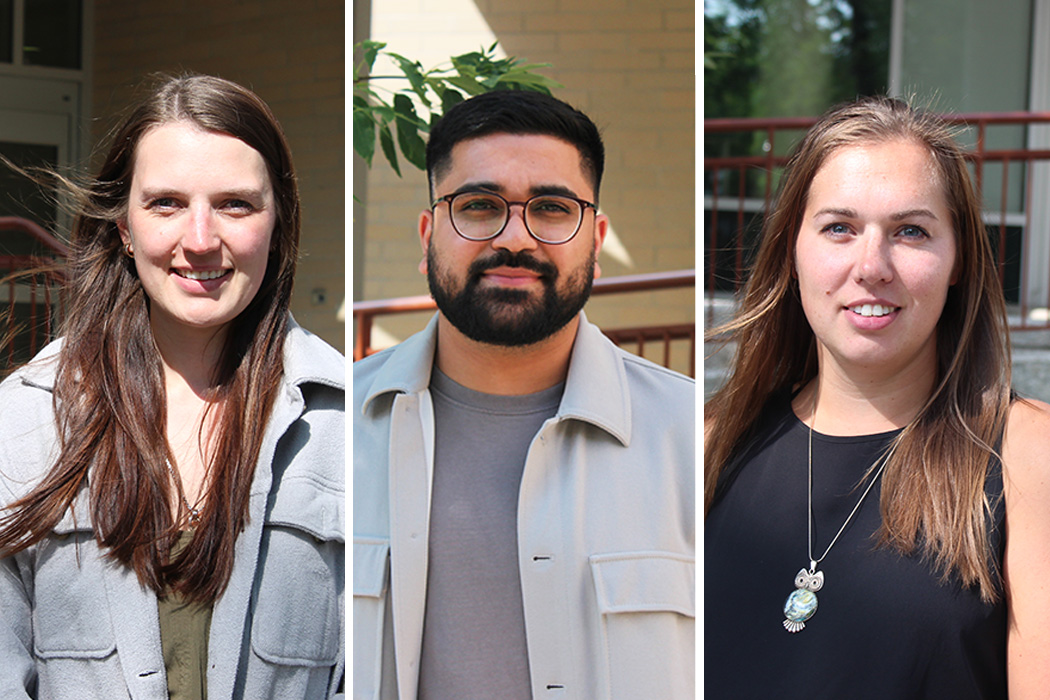
Mariah Pankiewicz, Karandeep Bhamra and Holly Okaluk
Nurse practitioner program marks 25 years, helps address rural health system challenges
Twenty-five students entered the nurse practitioner (NP) stream of the College of Nursing’s master’s program this September, marking the 25th annual intake since the program launched in 1998.
Mariah Pankiewicz, Karandeep Bhamra and Holly Okaluk each come to the program this year with different backgrounds, but all with the same goal to address gaps in the health-care system.
Pankiewicz has been working as a public health nurse in the Interlake region for the last three years, focused on post-partum care, immunizations and harm reduction. She noticed a lot of people in the smaller communities she served don’t have a primary care provider. She hopes to bridge that gap and continue to help people with addictions after finishing the program.
“I’m passionate about nursing, but I want to do more,” she said. “With harm reduction, I’ve been handing out needles and naloxone kits, but I’m interested in the other end of the spectrum, talking with patients about treatment plans.”
Bhamra has worked in various emergency and urgent care departments since 2020, when he graduated from the UM bachelor of nursing program. Working in both Selkirk and Winnipeg, he saw the gaps in health care from both an urban and rural perspective that were amplified by the COVID pandemic. He said in an emergency setting, nurse practitioners can be better utilized to help address the increasingly long wait times.
“Our scope of practice allows us to see more patients, minor or acute, allowing us to optimize the flow of the emergency department or urgent care,” he said. “If possible, I’d like to continue to work in critical care, but I’m also interested in rural medicine, where resources are limited.”
Okaluk grew up in St. Anne, a small community in southeastern Manitoba, and looks forward to working as an NP in rural and remote areas. She was inspired to join the program after working with an NP at a quick care clinic in Winnipeg.
“She was my role model. At the clinic, it was very much ‘get a patient in and get a patient out,’ but she took things slower and took everything in consideration,” she said. “She had a holistic approach and really cared for her patients. That preventative care, taking care of something before it becomes a concern, I thought, ‘that’s what I want to do one day.’”
When the program was initially launched in 1998, it was called the master’s in advanced practice nursing. There were only two faculty members at the time, compared to a team of seven today.
Lori Dziewit was among the first graduates of the program, starting in 1998 with two colleagues. She had previously worked in northern communities after graduating with her bachelor’s degree in nursing from UM. Today, she works as an NP at a primary health centre in Oakbank, Man., located just outside of Winnipeg, and as an instructor at Red River College Polytechnic.
She was inspired by working in northern communities with mentors who were among the first nurse practitioners in Manitoba. She said it was exciting to be in the program as it was new, but said it involved educating a lot of people on the role itself.
“At the time, no one knew what a nurse practitioner was. I loved how much it pushed the nurse role into an expanded scope, to serve communities that didn’t otherwise have doctors or other health-care providers,” she said.
“Looking back, it was so new [that] there were no nurse practitioners to mentor us in our clinical experiences, so we had mostly physicians as preceptors, and worked alongside residents to get that experience.”
Cheryl Jacobs, director of the NP program, said the scope of practice for nurse practitioners and the demands for care have grown over the last 25 years.
“Nurse practitioners are meeting the needs of Manitobans in every area of health care now and the opportunities for the graduates continue to grow as well. It is really exciting to see the possibilities for our profession and graduates,” Jacobs said.






